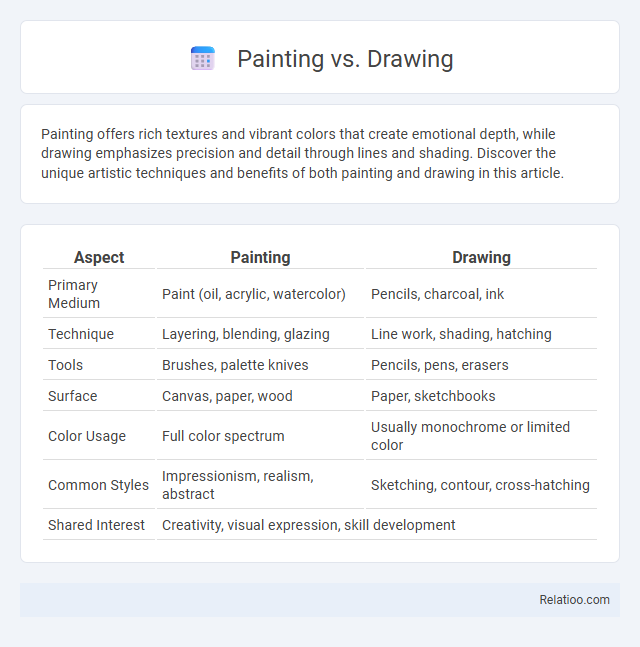Painting offers rich textures and vibrant colors that create emotional depth, while drawing emphasizes precision and detail through lines and shading. Discover the unique artistic techniques and benefits of both painting and drawing in this article.
Table of Comparison
| Aspect | Painting | Drawing |
|---|---|---|
| Primary Medium | Paint (oil, acrylic, watercolor) | Pencils, charcoal, ink |
| Technique | Layering, blending, glazing | Line work, shading, hatching |
| Tools | Brushes, palette knives | Pencils, pens, erasers |
| Surface | Canvas, paper, wood | Paper, sketchbooks |
| Color Usage | Full color spectrum | Usually monochrome or limited color |
| Common Styles | Impressionism, realism, abstract | Sketching, contour, cross-hatching |
| Shared Interest | Creativity, visual expression, skill development | |
Introduction to Painting and Drawing
Painting involves applying pigments to surfaces using tools like brushes or knives, emphasizing color blending and texture creation, while drawing focuses on marking surfaces primarily with pencils, charcoal, or ink to produce lines and shading. Both are foundational visual arts activities that develop observation, fine motor skills, and artistic expression. Introduction to painting and drawing typically covers basic techniques, color theory, and composition, forming essential skills for artists in various creative disciplines.
Defining Painting and Drawing
Painting involves applying pigment to a surface with brushes or tools to create images characterized by color, texture, and depth, while drawing primarily uses lines and marks with pencils, pens, or charcoal to represent shapes and forms. Both activities serve as fundamental artistic practices, but painting emphasizes layering and blending of colors, whereas drawing focuses on precision and detail through line work. Your choice between painting and drawing depends on the desired expression and the materials that best suit your creative process.
Tools and Materials: A Comparative Overview
Painting utilizes brushes, palettes, and various types of paint such as acrylic, oil, and watercolor, emphasizing surface texture and color blending on canvas or paper. Drawing relies on pencils, charcoal, ink, and markers to create detailed lines and shading typically on sketchpads or high-quality paper, focusing on precision and control. Both activities require specific tools tailored to their mediums, with painting demanding materials suited for layering and color mixing, while drawing emphasizes instruments that allow fine line work and texture creation.
Techniques Unique to Painting
Painting techniques such as glazing, impasto, and alla prima uniquely influence texture and depth, distinguishing it from drawing. The use of diverse mediums like oils, acrylics, and watercolors enables painters to manipulate color intensity and blending in ways that pencil or ink cannot replicate. Unlike drawing, painting often incorporates layering and varied brushwork to create dynamic visual effects and dimensionality.
Techniques Unique to Drawing
Drawing techniques uniquely emphasize line work, shading, and textural details achieved through tools like pencils, charcoal, and ink, enabling precise control over fine details. Unlike painting, drawing often relies on hatching, cross-hatching, and stippling to create depth and dimension without the use of color blending. These techniques facilitate quick sketches and detailed renderings, highlighting structure and form with clarity unmatched in other artistic activities.
Artistic Expression: Differences in Visual Impact
Painting offers rich textures and vibrant colors that create a dynamic and immersive visual experience, while drawing emphasizes line work and shading to deliver detailed and precise representations. Your choice between painting and drawing affects the intensity of emotional expression, as paintings evoke mood through color contrasts and brushstrokes, whereas drawings rely on form and structure to convey meaning. Both activities provide unique artistic expression, but painting tends to create a more impactful and bold visual statement compared to the often subtler, intricate nature of drawing.
Learning Curve and Skill Development
Painting offers a rich learning curve, emphasizing color theory, brush techniques, and layering, which enhances your ability to express depth and emotion. Drawing develops fundamental skills in line, form, and shading, building a strong foundation for visual understanding and precision. Both activities foster creativity and hand-eye coordination, but painting generally requires more time to master complex textures and color blending, while drawing accelerates skill development in observation and detail.
Popular Styles and Movements in Painting vs Drawing
Painting popular styles include Impressionism, Abstract Expressionism, and Surrealism, characterized by vibrant brushstrokes and color exploration. Drawing's movements, such as Realism, Cubism, and Figurative Art, emphasize line work, shading, and form with mediums like charcoal or pencil. Your choice between painting and drawing impacts the artistic techniques and styles you engage with, shaping your creative expression.
Choosing Between Painting and Drawing: Factors to Consider
Choosing between painting and drawing involves evaluating factors such as preferred medium, desired level of detail, and artistic goals. Painting often requires materials like brushes, paints, and canvases, offering vibrant color blending and texture, while drawing relies on pencils, charcoal, or ink for precision and line work. Consider time commitment and space requirements, as painting can demand longer drying periods and larger setups compared to the portability and quick execution of drawing.
Conclusion: Which Is Right for You?
Choosing between painting, drawing, and other artistic activities depends on your personal preferences, goals, and desired skill development. Painting offers rich color exploration and fluid expression, while drawing emphasizes precision, line work, and foundational techniques. Consider your interest in medium, time commitment, and creative outcomes to determine which art form aligns best with your artistic journey.

Infographic: Painting vs Drawing
 relatioo.com
relatioo.com